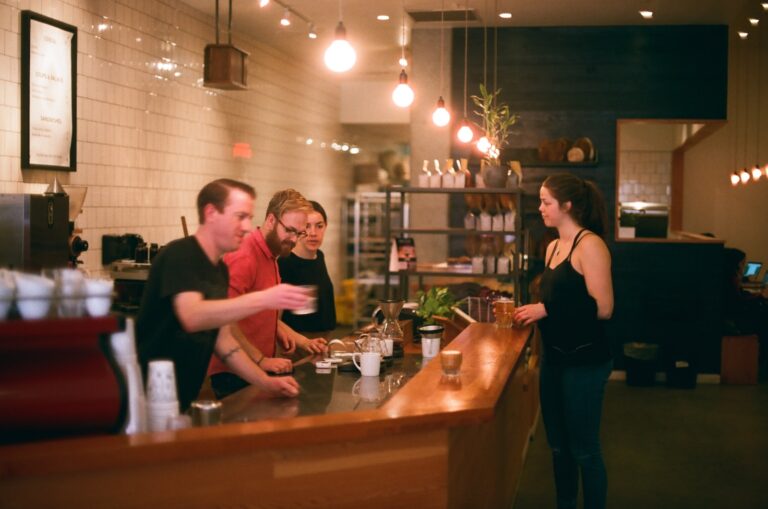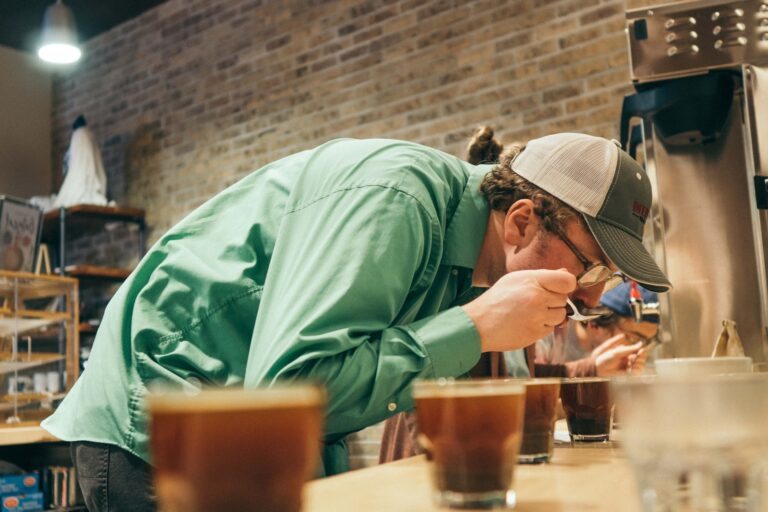Do you find that your productivity levels plummet after a few hours in the same mundane environment? Well, fret no more! The rise of co-working cafes is here to revolutionize your work-life balance. Imagine sipping on a perfectly brewed cup of coffee while surrounded by like-minded individuals, all buzzing with creativity and motivation.
In this blog post, we will delve into the fascinating world of co-working cafes and uncover how these trendy spaces are reshaping our traditional notions of work and providing an invigorating boost to our productivity. So grab your favorite mug and get ready to explore the perfect blend of coffee and work!
Introduction to the concept of co-working cafes and how they have become popular in recent years

The traditional workplace has undergone a major transformation in recent years with the rise of co-working spaces. These shared offices have provided an alternative to the standard office environment, offering freelancers, entrepreneurs and remote workers a collaborative and dynamic atmosphere to work from. However, co-working spaces not only exist within dedicated office buildings but also in an unconventional setting – cafes.
Co-working cafes are essentially coffee shops that provide a space for individuals to work while enjoying their favorite cup of joe. They typically offer amenities such as high-speed internet, printing facilities, power outlets and comfortable seating options for long hours of work.
The idea of working from a cafe is not new; writers and artists have been known to frequent coffee houses for inspiration and productivity for centuries. However, it was not until recently that the concept evolved into formalized co-working environments.
The popularity of co-working cafes can be attributed to several factors. Firstly, with the rise of remote working and freelancing opportunities, there has been a growing need for flexible workspaces outside traditional offices. Secondly, the increasing number of millennial professionals who value community and collaboration over individual success has contributed significantly to this trend.
Additionally, co-working cafes provide an escape from the isolation that can come with working from home or in a traditional office setting. They offer an opportunity for social interactions and networking with like-minded individuals who may share similar interests or skills.
The benefits of working from a cafe, such as increased productivity and community building
Coffee shops have long been a popular place for people to catch up with friends, grab a caffeine boost, or simply relax and do some people-watching. However, in recent years, coffee shops have also become increasingly popular among remote workers and freelancers looking for a change of scenery from their usual workspaces. This trend has led to the rise of co-working cafes – spaces that cater specifically to those who want to work while enjoying the ambiance and amenities of a bustling cafe.
One of the main benefits of working from a cafe is increased productivity. The change of environment can be refreshing for those who are used to spending most of their days indoors at home or in an office cubicle. The natural light, ambient noise, and overall atmosphere in a cafe can help stimulate creativity and focus. Additionally, being surrounded by other individuals who are also working can provide motivation and accountability to stay on task.
A history of coffee shops as places for writers and artists to work and collaborate
Coffee shops have always been popular gathering places for writers and artists looking for a quiet space to work and collaborate with like-minded individuals. The history of coffee shops as creative spaces dates back centuries, with the first coffee houses appearing in the Middle East during the 15th century.
In Europe, coffee houses became centers of intellectual thinking and free expression during the Enlightenment period in the 17th and 18th centuries. Writers, philosophers, and artists would convene in these establishments, discussing ideas and exchanging knowledge over cups of freshly brewed coffee. These gatherings were not only a way for creatives to fuel their minds but also served as a form of socialization.
During the 19th century, Parisian cafes became famous meeting spots for writers such as Ernest Hemingway, F. Scott Fitzgerald, and Gertrude Stein. These cafes provided writers with a relaxed atmosphere to work on their craft while also providing an opportunity to connect with other creative individuals. It was during this time that cafe culture became intertwined with artistic expression.
Coffee shops continued to evolve as hotspots for creative collaboration throughout history. In New York City’s Greenwich Village during the 1950s and ’60s, beatnik poets could often be found typing away at their typewriters in dimly lit cafes such as Caffe Reggio or Café Figaro. These cafes provided a sense of community for writers seeking inspiration from each other’s work while sipping on espresso.
In more recent years, coffee shops have become synonymous with the rise of independent and self-published writers. With the advent of laptops and Wi-Fi, coffee shops offered a convenient and affordable alternative to traditional office spaces. This allowed writers to work independently while still being surrounded by the buzz of creative energy in a public space.
Coffee shops also play a significant role in providing a platform for artistic events and performances. In cities such as San Francisco, Seattle, and Portland, coffee shop stage nights have become popular for poets, musicians, and comedians to showcase their talents to a supportive audience.
The rise of technology has also led to the emergence of virtual coffee shops where creatives can connect and collaborate online through platforms such as Skype or Google Hangouts. These online spaces provide opportunities for writers from different parts of the world to come together, share ideas, and collaborate on projects.
How technology has made remote work more accessible, leading to the rise of co-working cafes
The advancements in technology have completely transformed the way we work and communicate with others. With the rise of remote work, people are no longer confined to traditional office spaces and can now work from anywhere with an internet connection. This has led to the emergence of co-working cafes as popular workspaces for professionals, entrepreneurs, freelancers, and digital nomads.
Remote work has become more accessible thanks to a variety of technological tools that make it possible to connect and collaborate with others virtually. The first key component is reliable and high-speed internet access. With the widespread availability of public Wi-Fi networks coupled with personal mobile hotspots, individuals can now access the internet easily from their laptops or smartphones in any public space.
Another essential tool for remote workers is cloud-based software that enables them to store data online and access it from any device. This eliminates the need for physical storage devices like USB drives or external hard drives, making it easier for individuals to travel light and be productive on-the-go.
Communication tools such as video conferencing apps, messaging platforms, and project management software have also made remote collaboration smoother than ever before. These tools allow team members to communicate effectively regardless of their physical location. As a result, remote workers can maintain constant communication with their colleagues without having to be physically present in an office space.
The availability of virtual office spaces and shared workspaces has also contributed to the rise of co-working cafes. These spaces provide a professional setting for individuals to work remotely, with access to amenities such as high-speed internet, meeting rooms, and printing services. Co-working cafes offer an affordable alternative to traditional office spaces, making it convenient for remote workers who may not have the resources or budget for a dedicated workspace.
Moreover, co-working cafes allow individuals to separate their work life from their personal life by providing a dedicated space for work. This is especially helpful for those who work from home and may struggle with productivity due to distractions.
Co-working cafes also foster a sense of community among remote workers. In these spaces, individuals can meet and network with like-minded professionals in a relaxed environment. It provides an opportunity for social interaction, which can be lacking in remote work setups.
In conclusion, technology has played a significant role in making remote work more accessible and efficient, paving the way for the rise of co-working cafes as popular workspaces. As technology continues to evolve, we can expect remote work and co-working spaces to become even more prevalent in the future.
The role of coffee in boosting creativity and focus while working
Coffee has long been known to be a popular beverage for its ability to boost energy and keep people alert. However, what many may not realize is that coffee also plays a significant role in enhancing creativity and focus while working. In this section, we will discuss how coffee impacts the brain and its effects on an individual’s productivity at work.
The first way in which coffee enhances creativity and focus is by stimulating the central nervous system. Coffee contains caffeine, a natural stimulant that is quickly absorbed into the bloodstream and travels to the brain.
Once in the brain, caffeine blocks the inhibitory neurotransmitter adenosine, which promotes feelings of drowsiness and slows down neural activity. By blocking adenosine, caffeine allows other neurotransmitters such as dopamine and norepinephrine to increase in levels, leading to an increase in energy levels and alertness.
As a result of increased energy levels and alertness, individuals find themselves more focused and motivated while working. This increased motivation can lead to higher productivity levels as they are better able to concentrate on tasks at hand without feeling fatigued or distracted. Furthermore, caffeine has also been found to improve reaction time and decision-making abilities, thus making individuals more efficient when it comes to completing tasks.
In addition to its physical effects on the brain, coffee has also been shown to impact an individual’s mood positively. Studies have found that caffeine can enhance mood by increasing the levels of neurotransmitters such as serotonin and dopamine, which are responsible for feelings of happiness and well-being. As a result, individuals may feel more positive and optimistic about their work, which can lead to increased creativity and productivity.
Moreover, research has also suggested that coffee may enhance divergent thinking, a critical aspect of creative thinking. Divergent thinking is the ability to generate multiple ideas and solutions for a problem. One study found that participants who drank caffeinated coffee before engaging in a creativity task produced significantly more original ideas compared to those who did not consume coffee.
On top of its cognitive effects, the act of drinking coffee in itself can also be beneficial for boosting creativity and focus while working. The ritualistic aspect of making or buying a cup of coffee can provide a small break from work and serve as a mental reset before delving back into tasks. Furthermore, taking breaks throughout the day is crucial for avoiding burnout and maintaining productivity levels.
Conclusion
In today’s fast-paced and interconnected world, co-working cafes have become a popular choice for professionals looking for a change of scenery while they work. The combination of caffeine and a collaborative environment has proven to be an effective way to increase productivity and creativity.
As more people embrace this new way of working, we can only expect the trend of co-working cafes to continue rising in popularity. So next time you need to get some work done, why not try out one of these unique and dynamic spaces? Who knows, it might just become your new favorite spot!







